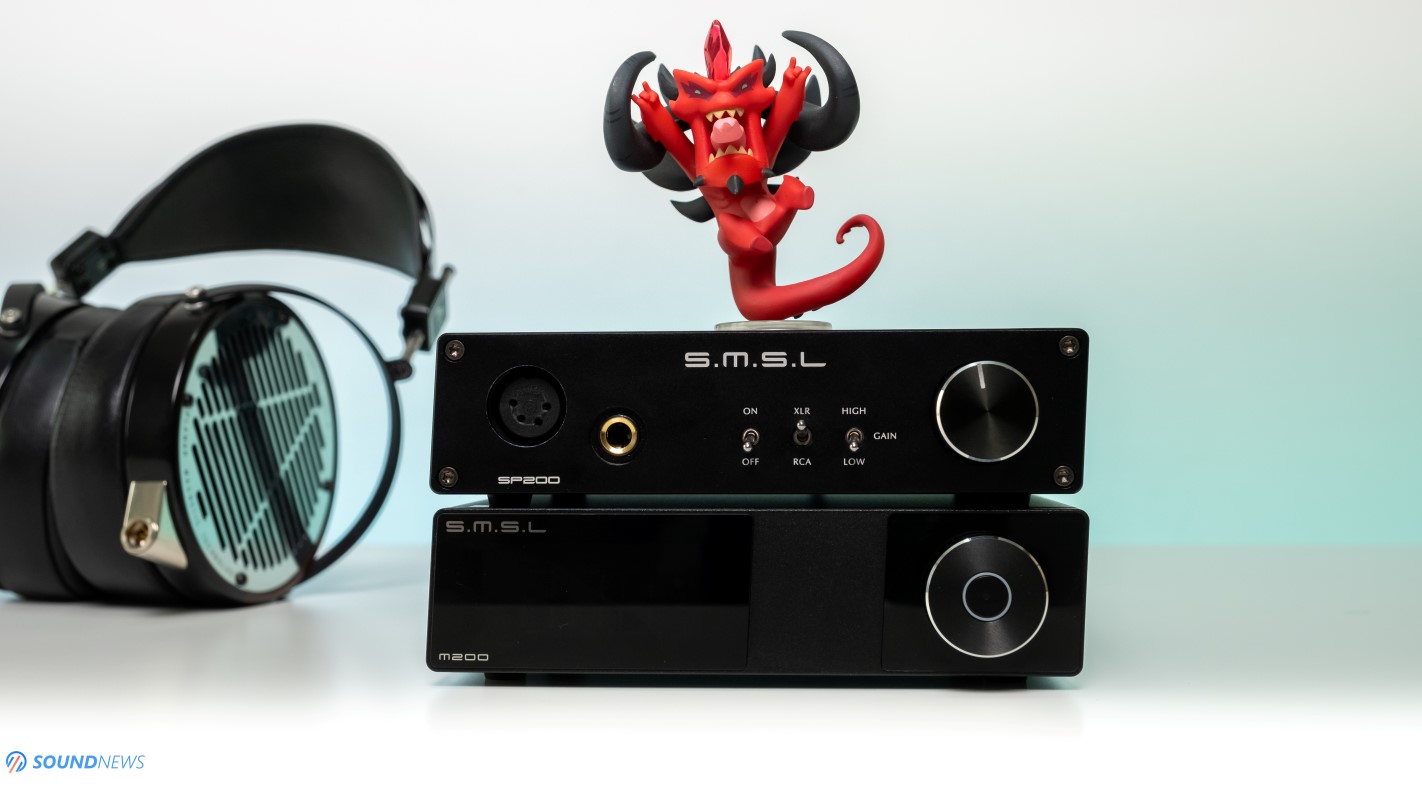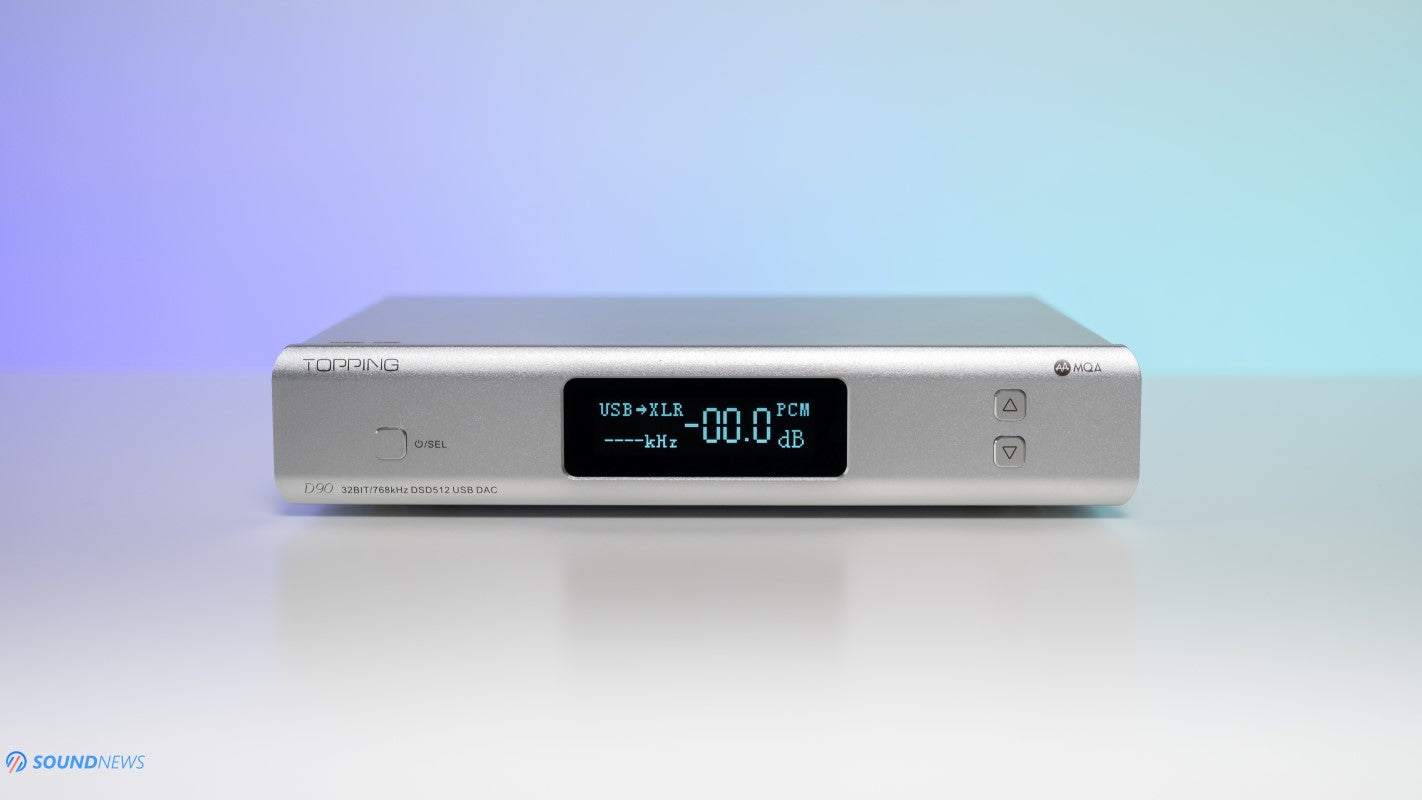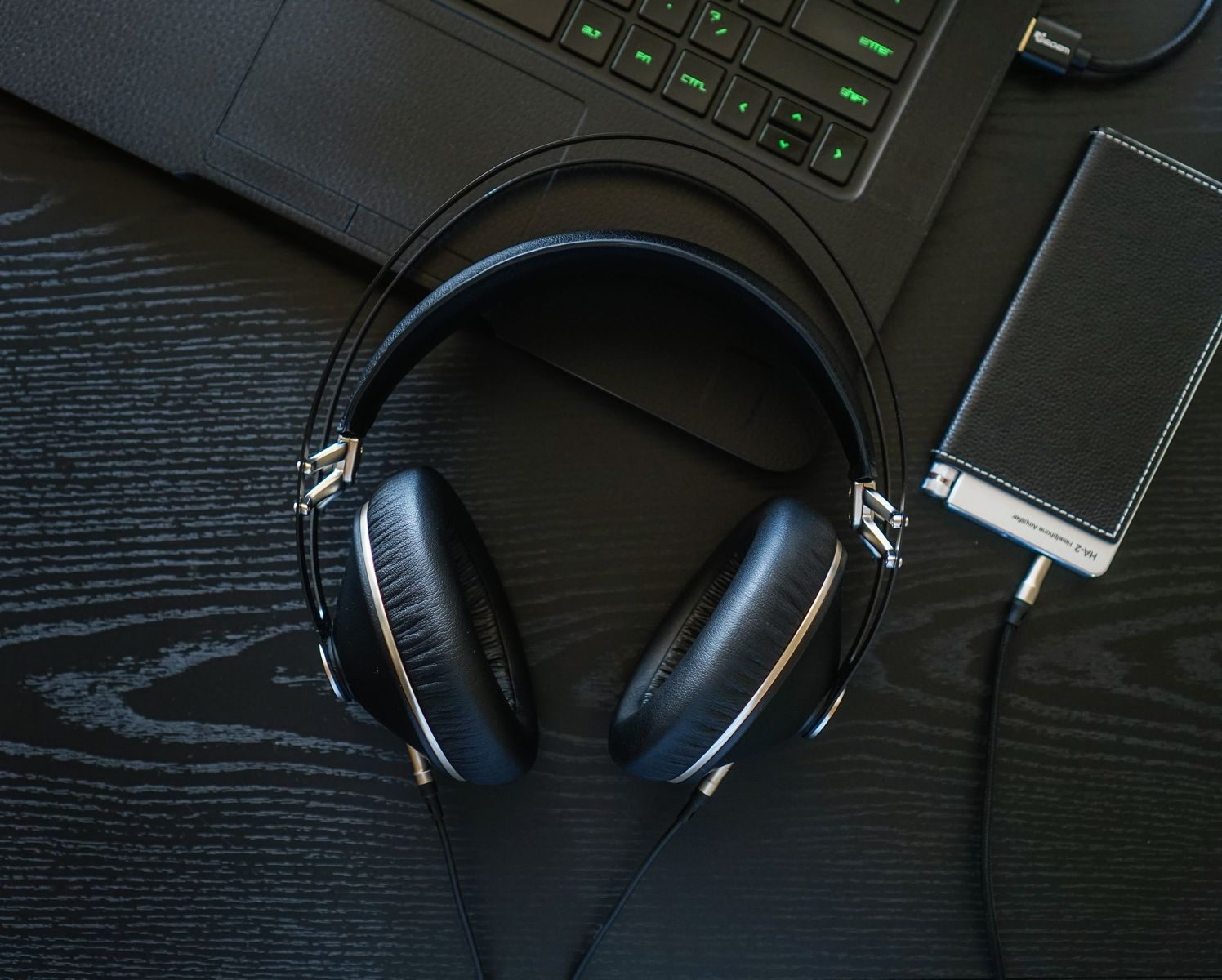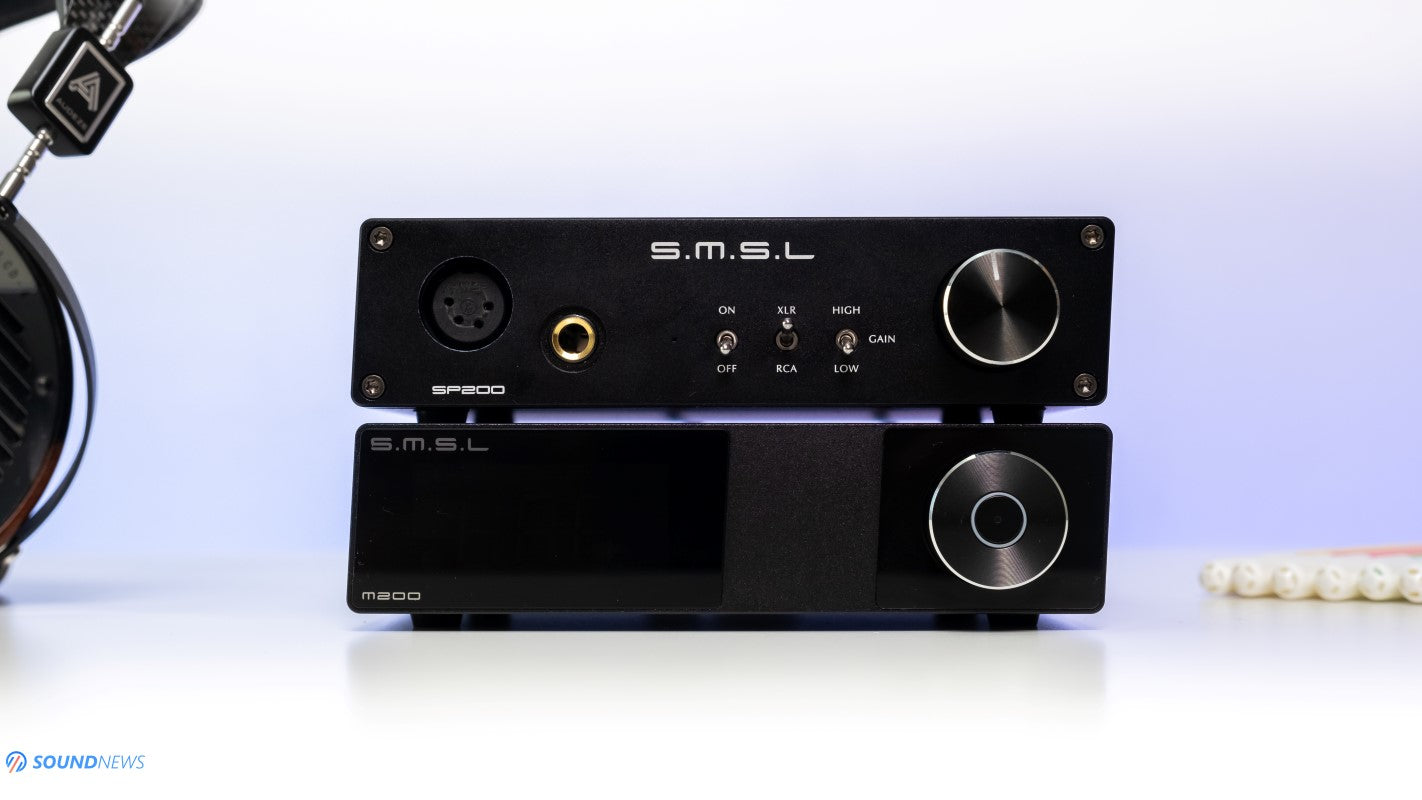
SMSL M200 DAC Review
This review is posted here in partnership with Soundnews.net. It was originally written and published by Sandu Vitalie of Soundnews.net on June 5, 2020.
When SMSL released their SP200 – a THX based achromatic audio headphone amplifier, it created ripples in the headphone amp market due to its great sound quality, high output power and super affordable price point. That product was one of the main reasons Drop lowered the price of their THX AAA-789 by exactly $100, so they could compete with SP200 and take back a big slice of pie in the ~$300 price bracket.
With the freshly released M200 DAC that I will be testing today, SMSL will again try to land a critical blow to the affordable DAC market, offering more features, better electronics and hopefully a better musical experience for less money. The M200 DAC is targeting not only the SP200 fanbase by having the exact same dimensions and build quality, it also targets a wider audience of speaker lovers by incorporating a simple digital preamp in 40 steps. With a price point of only $279 in USA and €299 in Europe, SMSL M200 is quite an interesting digital to analog converter and I will explain you why very shortly.

Unboxing & Package Contents
It came double boxed as most of the high-quality stuff is coming nowadays, the smaller product box is full of foam for extra protection measures. Its body felt lighter compared to their SP200 headphone amp, normally it is the other way around – source being on the lighter side and amplifier on the heavier side. After seeing its external switched-mode power supply (or SMPS for short) in the package -everything became clearer to me, by comparison SP200 has an internal power supply, hence the weight difference. In the package you will also find a Bluetooth antenna that also works as a BT signal booster, a USB type-B cable, a user manual and a neat remote control which should help you a lot in a speaker setup. I strongly recommend checking the user manual first for some tips & tricks and for some detailed specs.

Design & Build Quality
M200 together with SP200 and with M400 are one of the few designs made by SMSL that are looking good to me. Most of their units have odd shapes, elongated bodies, small screens, weird volume knobs and so on. I seriously think SMSL should choose one single design and stick to it, releasing multiple devices with the same dimensions and look, so they would be recognizable without looking at the logo, building a strong brand identity in the process. M400 is by far their most good-looking device and I wish all their future products would have the same look.
M200 is looking like a simple black brick, the case seems to be milled on a CNC machine, its thick and the panels on the front and back are even thicker. The front panel houses a little bit of glass with an LCD screen behind it. The volume knob feels better compared to the cheaper variant of SP200. There are rubber feet underneath it put in small cut-outs so they would not wobble around. I find the build quality pretty nice and I have close to zero complaints.
In typical SMSL fashion, instead of leaving it look like a perfectly normal brick, they leaned the case a bit at an angle to match the case of SP200. It is not a deal-breaker to me, but should be mentioned, here’s a photo on top of a SP200 just to be clearer.
I’m glad SMSL went with a much bigger screen compared to their DA-8S and Sanskrit 10th MKII units, which had it way too small to be comfortable in the living room. It has 3 brightness positions and by default it will show the sampling rate of your music, the selected input and the volume level.

Controls & Connectivity
M200 has a simple front panel, with just an LCD screen on the left and a volume knob on the right, so it can’t be simpler than that. The biggest part of the front panel is occupied by that big LCD screen – this is probably the best decision they made about this unit, the lettering is big and I can easily see them far away from the unit in a speaker setup. If you don’t plan on using the M200 as a preamp, I recommend putting the M200 in the DAC mode by pressing the FN button on the remote.
It might have a small body, but it looks like a serious DAC once you take a glance on its back plate. You can find the usual RCA and XLR outputs – both can be controllable or fixed. On the digital side you will spot the usual USB, coaxial and optical. There is also a Bluetooth antenna socket – simply screw it with your hand and that’s it.

Menu Options
All the features of M200 can be controlled via the remote control or via the volume knob that doubles as a joystick for its menu. In the stand-by mode a single press on the knob will power it on, another press and you will be choosing between 4 digital inputs: USB, coaxial, optical and Bluetooth.
A double press on the knob will enter a special menu where you can choose:
- 6 digital filters incorporated on the hardware level of the DAC chip itself, I recommend checking the manual to know which is which, I personally like filter number 4 a bit more (FL4).
- DSD filter is next – I recommend leaving it at first position - dF1.
- You can bypass the volume for DSD material and for that you should select dP1.
- The next setting will let you choose from 3 different sound tunings or “Sound Color” as SMSL is calling it, SC1 is their most neutral sound tuning, so I’m liking it a bit more.
- The last setting will let you choose between 3 brightness levels, bL3 being the brightest and bL1 the least bright.
On the remote control there are few additional features, to learn them all please check the user manual first.

Tech Specs & Detailed Information
I believe this is exactly where SMSL is the proudest, having some interesting features and a nice selection of components which usually you will find in much pricier DACs.
Going for a high-end commercial DAC chip, like the AK4497EQ from the Japanese manufacturer Asahi Kasei, was their best decision yet. This is a very advanced silicon that you will normally find in expensive to very expensive units. Here are some sources that I have tested around here that are using the same chipset as a point of reference: Aune S6 PRO – a $600 unit, Topping D70 – a $500 unit, FiiO M11 Pro had it as well, but it costs $650. SMSL already impresses by choosing a good sounding chipset that is more than capable of great sonics.
To this day, the most stable USB chipset for me were the ones from XMOS and SMSL went with their second-generation chips, I’m sure it is the XUF-208 that never let me down in any situation. It rejects noise from the source (PC/Mac) and it always worked glitch free for me. XUF-208 is capable of receiving 32 bit/768 kHz PCM and DSD512 data streams, so its really fast, reliable and good performing.
SMSL went with an external SMPS, so obviously it hasn’t any kind of transformer inside – usually that translates into a higher noise floor. However, the sneaky SMSL added a high-performance encapsulated voltage regulator that will clean up that power and lower the noise floor to very low levels, SMSL is calling this circuit “power purification system”.
To squeeze some juicy bits of data from that AK4497 DAC chips, besides a really good power filtering, some precise crystal oscillators are needed, SMSL put two ultra-low noise clocks inside it that should cover most of the PCM and DSD material.
One of the most interesting features is using the latest Qualcomm Bluetooth chipset, besides the usual stuff as SBC, AAC, AptX, AptX-HD and AptX-LL, it can also receive data in LDAC codec (up to 990 kb/sec) and in the newest UAT codec that stands for Ultra Audio Transmission – it’s an audio codec with up to 192 kHz sampling frequency and up to 1.2 Mb/sec bit rate - it simply outperforms all other audio codecs. UAT is so new, that most of the newest smartphones doesn’t support, mine included, as I understand only the newest Huawei phones are having it and many other brands should support it very soon as well.
In my opinion, M200 has the right ingredients a high-quality DAC should have: a good DAC chip, a good USB interface, good power filtering, decent quality crystal clocks that should solve the timing errors. Add the newest UAT Bluetooth codec and suddenly M200 becomes a very advanced and desirable DAC.
So, what are waiting for, let’s check how it sounds.

Sound Performance
I. Preliminary Impressions
I know that it has only two bigger electrolytic caps and few smaller ones, there isn’t a transformer inside it, so naturally less burn-in time was needed compared to much bigger DACs. Nonetheless, it is playing for about a week now, that is more than enough for it to bloom and show all its best traits.
I also wanted to help the SP200 owners by making a combo between the two and listening in this setup most of the time. M200 was also connected to a HPA4 by Benchmark so I could see it better and feel all its pros and cons. In a speaker setup it was used as DAC + preamp combo attached via balanced XLR to a KECES S125 power amp that was driving a pair of Buchardt S400 loudspeakers.
I wanted to hear if there would be any benefit from using a passive power conditioner with it, so I tested it with and without a Plixir Elite BAC400. The good news is that BAC400 doesn’t change it that much, I’ve heard an improvement mostly in the bass department, I’m feeling a stronger kick in there and slightly more air moving in that region too. The background is already clean, without any disturbing gremlins ruining my listening experience. Even listening via sensitive IEMs showed a clean background without any kind of residual noise. A passive power conditioner is not really needed with this DAC, some good news for the music lovers that don’t have the cash to shelve for a top-of-the-line DAC with a state-of-the-art power supply.

II. Sound Signature
M200 definitely reminds me a lot about the naturalness and airy presentation of the $599 Aune S6 Pro with the smoothness and relaxing nature of the $500 Topping D70, to me M200 is really playing in the same ball-park. It might lose in terms of features and connectivity compared to those bigger and more expensive sources, but it is playing on the same level when it comes to sound quality.
I like that SMSL went with a slightly stronger signal of 4.1 V on the XLR out that works amazing well with their SP200 headphone amp. With most of my headphones, low gain is enough and I’m switching to high-gain only with Hifiman Arya and Audeze LCD-4.
With the later ones, I was able to discern smallest details that a high quality source should provide, there was definitely a slight warmth all over my music, tones felt richer, voices sounded fuller and weightier, that midrange stole my attention most of the times . Bass felt nimble and fast but it was not awakening some earth-shaking sub-bass notes, for that a more powerful output-stage would be needed. Treble had spark that could ignite some fiery music, I particularly enjoyed listening to some crowded Zen-Funk that extracted the best M200 could deliver.
M200 lacked only when it came to slam and heft that usually a +$1K source will deliver, the highest top-octave didn’t feel as detailed, as extended and as outlined as it sounds on much more expensive units. It lacked the cojones a dedicated preamp could deliver in a speaker setup, the surgical accuracy of an all-discrete output stage and the ultimate frequency extremes felt a bit rolled-off, but everything else was in-there in spades and I quite enjoyed my time with it in a headphone and speaker setup.
I was also quite impressed by the left to right soundstage with both headphones and speakers, I know SMSL used a single stereo DAC chip, so naturally this isn’t a true balanced signal, yet somehow the left to right soundstage feels as wide and stretches exactly as a quad-channel DAC would do. M200 somehow wants to impress with its musical wizardry, with that spread soundstage in a 2D field, adding a bit of warmth and chasing away all that brightness and digitus that plagues most on the modern over-mastered music.

III. Soundstage & Depth
This is one of the main positives I could mention about M200. I opened it up myself and I’ve seen only two bigger caps that are storing energy for big dynamics swings, leaving an impression that it should move less air compared to much bigger sources. At the same time I remembered how open and wide those truly affordable Topping E30 and SMSL Sanskrit 10th MKII DACs sounded with even smaller capacitors in their cases, so I’m really open to anything at this point.
Listening to a decently mastered album which was recorded with an omnidirectional microphone - Samantha Crain & Midnight Shivers – Songs in the Night, after pressing play I felt being the centerpiece - the microphone in that recording studio, being simply surrounded by people and by sounds. I felt that this album was recorded in a smaller space, notes weren’t flying too far away from me and I’ve felt very comfortable listening to this record in the speaker setup. Samantha’s voice felt more like whispering and that guitar felt being in my hands, a weird but a pleasant experience nonetheless.
When I moved to live recordings made it big auditoriums, the walls weren’t that obvious anymore and from a shoulder level soundstage with headphones it moved much farther away from me. I genuinely think that soundstage and air movement in the any track is done on a high level with M200.
As a small detour, pricier ESS Sabre based DACs are sounding closer to me, sometimes even claustrophobic with few particular songs that makes me uncomfortable. M200 is pushing that clutter farther away from the listener and adds the much-needed air and space between each note, making the overall presentation bigger in size, making me feel inside of a much bigger balloon filled with music. It is not a secret anymore that most of the AKM chipsets are choosing an out of head experience, a wider and deeper presentation in detriment of a harder punch in the chest and into ear-drums and M200 felt exactly like that.
I felt depth information mostly with great mastered music and only with the best headphones and speakers, translating in a sound that is wide and open but not very deep. I’m feeling the sound going wide and tall on the X and Y axes, but not so much on the Z axe, so it’s not a complete 3D experience and more like a 2.5D experience if you will. For a great depth, a better power supply and filtering will be needed and a much more powerful output stage as well. I’m expecting an amazing depth only with +$1K sources so it shouldn’t come as a surprise to anyone.

IV. Transparency & Detail Retrieval
If you ever heard any THX amplifier by now, you would know that those are mostly colorless and straight as a line when it comes to frequency response, tonality and sound signature, they simply beg for a bit of soul, for a higher musical involvement that naturally should come from the source. I’m very glad that SMSL went with an AKM silicon in detriment of an ESS Sabre one that might do more harm than good to any THX amp. I’m generally speaking, because with extra care and with a good tuning you could make an ESS Sabre DAC having all the warmth and soul you could possibly desire.
I feel that M200 fights back some of the cons of SP200, tames a bit of brightness, adds a much-needed soundstage that SP200 lacks and most importantly adds warmer tones, awaking emotions in music that SP200 simply couldn’t do on its own. Yes lads, M200 + SP200 is an amazing combo that should be hard to beat at this price point. If you are a headphone enthusiast and own the SP200, then M200 should be your next logical step.
Do note that the higher transparency and that amazing detail retrieval of SP200 could be easily strangled with a muddy sounding source. I’m glad to report that it is not the case with M200. Will SP200 sound even better with a higher performing source? Yes, it will, but so does M200 - it will sound better with a higher performing amp like the HPA4 by Benchmark. In the end, it is all about balancing the good and the bad and I consider that SMSL did that with flying colors.
The shimmers I’m feeling on few particular tracks are still there, the small feet movements are felt too, people inhaling and exhaling is defined and clear as well, so when it comes to details, M200 will perform on more than a decent level and will not feel embarrassed at all near a $3000 Matrix Audio Element X DAC. Sure enough, there are more resolute sources, but not at this price point so I’m very happy about M200 in this regard.

V. Transient Response
Now, this is where SP200 gives a helping hand to M200 awakening some of that slam and punch I so crave about with energetic music. M200 by itself is good but not amazing when it comes to slam and punch. I did head-bang with my rock tunes, I did raise my hands up, air-guitaring like a madman with M200, but I did the same with cheaper alternatives. On the other hand, M200 felt faster and punchier than the $500 Topping D70 that sounded smoother almost all the time. M200 will be smoother sounding only when music will be calling for that, otherwise it would sound snappy and quite energetic too. Just don’t expect being hit by a train while listening to snappy music and you’ll be fine.
When M200 was connected to the S125 power amp, powering some Buchardt S400 loudspeakers, I felt the thump in the chest, bass notes felt nimble, so in a right setup, M200 would be far from mellow, laidback or plain lazy sounding.
Firing some of my favorite neck healing music like Infected Mushroom – Only Solutions and coming back to the headphone setup, putting the Audeze LCD-4 back on my head, I felt how mood started rising fast and consistent. I simply felt an increased slam that would make my ears wave in the rhythm of the music. This particular song sounds amazing with headphones, if you don’t feel the slam hitting your ears with an impressive force on this track, then something is not right in that setup.
Probably the most interesting pairing was adding the Flux Lab Acoustics FCN-10 to the chain, that worked as a headphone amp only. I almost wanted to take off my headphones, because from a shy guy, M200 simply transformed into Speedy Gonzales, hitting hard and fast at the right moment, unleashing some amazing dynamics in the process.
Going back to M200 with SP200, this combo offered all the slam I wanted in my music, working really well with modern music. It can also sound as a gentle Ben with some relaxing acoustic music, so it really depends a lot more on your music and on the rest of the acoustic chain than on the M200 itself.
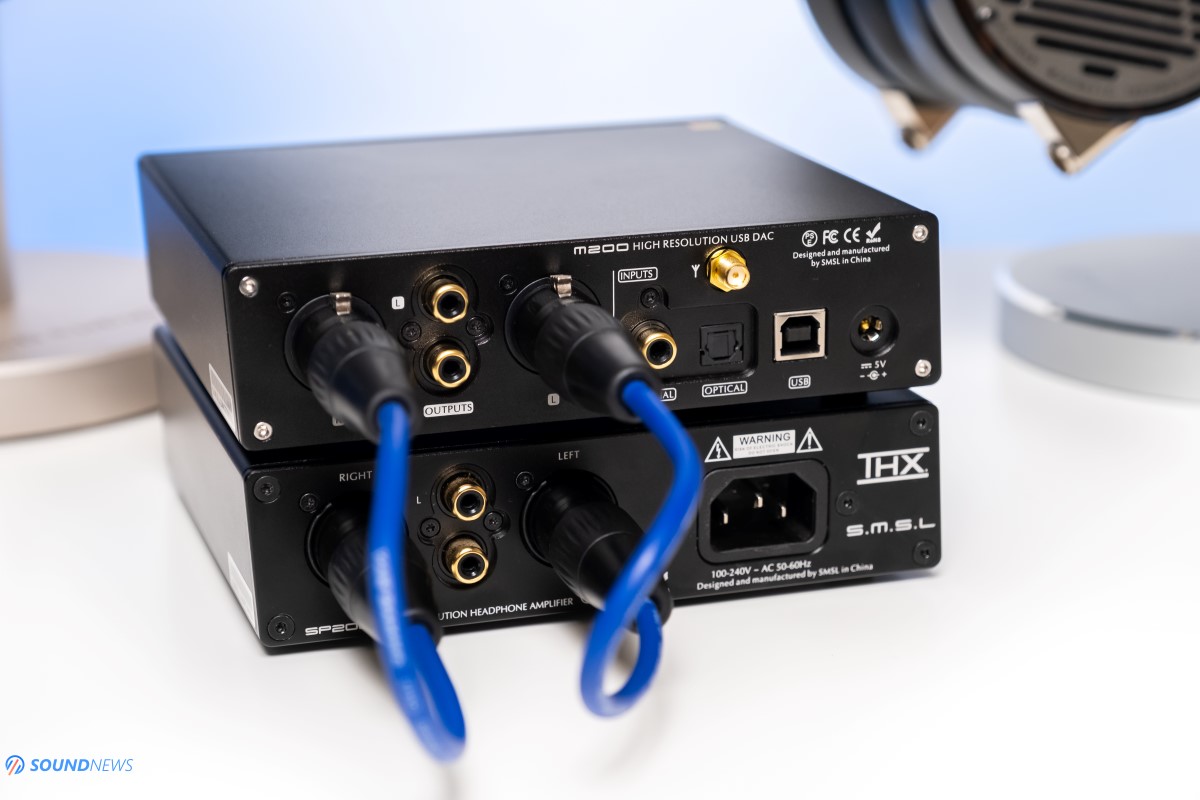
VI. Frequency Response
When I was testing one of the most affordable DACs from SMSL and by that I mean the Sanskrit 10th MKII, even with a weaker output stage, with less impressive electronics, it was able to offer a more than decent bass performance and while listening to the newest electronic albums, everything was at its place, including deep reaching sub-bass notes that were heard with headphones and felt with my whole body while listening to speakers.
M200 is slightly better in this regard and from hollow bass notes, I felt them heavier, more outlined, there is definitely more air moving down to the lowest octaves. I was able to hear those 20 – 25 Hz notes on The Prodigy – Invisible Sun and on James Blake – Limit to Your Love. M200 sounds slightly more technical in this region, highlighting bass detail more than the heft itself. Sub-bass notes were rendered good, there is a decent sustain while listening to a bass guitar for example, lowest notes will decay slower a bit so there is plenty of time to feel them with all your body. This particular region is rendered better on M200 that on pricier R2R offerings that are good sounding starting with mid-bass and upwards.
At first, M200 gave an impression that mid-bass is not as defined and not as meaty sounding as it was the case on its younger brother Sanskrit 10th MKII, but shortly after I realized that the later is simply having a weaker sub-bass portion, moving the spotlight to the mid-bass region. M200 is considerably more linear top to bottom, there aren’t any serious frequency cut-offs, there isn’t a spotlight on any region and it feels more complete from a frequency response standpoint.

Midrange is probably one of the nicest things about M200. It is not overdone, but it feels fuller in density, there is a bit more warmth in there, it is easier to spot voices playing on different tonalities. This is where M200 adds just a bit of its own flavor, showing its true personality. From flat sounding amps, speakers and headphones, it would infuse a bit of joy and listening pleasure. It particularly shined with any kind of acoustic music, highlighting the texture and the body of those acoustic instruments. M200 is simply one of those DACs that I would attribute words as natural, smooth but also warm sounding to a lesser degree.
Treble has a decent amount of detail and presence; even top octave can be easily spotted. I’ve felt the brass of the cymbals, snare drum hits felt visceral and clean sounding to me. It needs to be said that M200 will not highlight the highest registers, their leading edge is not super defined and outlined. I almost want to say it is rolled-off a bit in this region, but it’s not. It simply doesn’t attract a lot of your attention to this region so if you are looking for a worry and grain-free treble performance, then this is it. I didn’t encounter brightness on this unit, there is a gentle smoothing at the top, making it absolutely perfect for long listening sessions.
SP200 was very good in here and if M200 would be the same, by offering crisp and detailed top-octave, the tonal balanced could be shifting towards brightness and nobody wanted that. I believe that M200 was simply made for SP200, completing each other faults.

VII. Wireless Performance
My smartphone is Bluetooth 5.0 enabled, it supports all the major Bluetooth codecs as AptX-HD and LDAC, but sadly doesn’t support the newest UAT Bluetooth connection. I see that currently very few smartphones are having it, SMSL did their homework extremely well this time around and put a future proof Bluetooth receiver inside this unit.
After attaching the Bluetooth antenna that also works as a wireless signal booster, I simply selected the BT input on the remote, searched for SMSL HDBT with my phone, connected to it and it was ready to receive lossless files via LDAC at a resolution of up to 24 bit 96 kHz at the maximum rate of 990 kb/sec.
I’ve seen the same antenna on SMSL DA-8S, on Topping D50S, DX7 PRO and also on their flagship D90 and D90 MQA DACs. M200 works exactly like those units, so in a big apartment I was not losing signal if M200 would stay in the living room. I engaged Tidal Hi-Fi on my phone and I streamed some Tidal Masters directly to the M200 DAC and played all that via speakers. I walked in all the rooms and the signal remained always steady. It simply offered a flawless Bluetooth experience and in an open space it should work even better. When I went outside to the balcony, I’ve heard dropouts and stutters, but sincerely I was expecting that, as all other sources that I mentioned before did the same. Do note that there are 3 concrete walls between the balcony and the living room and about a 13 to 15-meter distance, so it offered a more than satisfactory experience for me.
If I would play some lossless files in 16-bit 44.1 kHz resolution – basically CD quality music, then the difference between playing those files via Bluetooth (LDAC codec) and via USB connection would be very negligible or really close to zero. In a blind test, I could hardly guess if it is playing via Bluetooth or wired via USB. I do hope that Ultra Audio Transmission (UAT) Bluetooth codec would be wider spread and embraced by the most smartphone manufacturers really soon. Keep in mind that there is still room for improvement and quite possibly the signal strength could be even better via UAT.

Conclusion
As it was the case of SMSL SP200 headphone amplifier that overnight became one of the most desirable headphone amplifiers on the market, carrying flagship THX-AAA-888 tech inside and a very low THD, it had all the key ingredients a great headphone amplifier should have at a very attractive price point.
SMSL M200 feels exactly like that as it screams high-performance, there is a lot of tech inside this one. A very capable or should I say top-class DAC chip is powering this unit, add that sound purification system that SMSL implemented, the newest Bluetooth chipset that supports Ultra Audio Transmission and M200 already feels like a winner at a very attractive price point of $279 in USA and €299 in Europe.
It definitely punched way above its price point offering great dynamics, good fluidity and lots of smiles while listening to it. It is one of those DACs that makes you add another album to your playlist, lean back and relax for a few hours.
I don’t want to sound like a fanboy, because I’m far from one, but at this price point, I really don’t know another source that will offer you the same number of inputs and output, the same electronics and the same balanced sound signature with close to zero flaws.
So, do I recommend it? Hell Yes I do! In the sub-$500 price category, this should be one of the most recommended units from now on.
SMSL M200 was provided by Apos Audio, it can be purchased from their webstore by following this link (they offer free shipping in the USA, lowest price guarantee, a 2nd year of warranty and a 30-day return policy in case you don’t like it).
PROS:
- Solid build quality with thick metal plates on the front and back
- Small footprint – could be easily integrated into tight spaces
- The remote is helping a lot in a speaker setup
- Excellent tonal balance, being slightly tilted towards warmth and naturalness
- Detail retrieval and transparency is at a very high level
- Good pin point imaging in a speaker setup
- Wide and tall soundstage size, with a decent depth
- One of the best transient response I’ve experienced in a AKM-based DAC
- Linear and extended frequency response
- Amazing Bluetooth codec support, it’s future proof too
- It the best buddy with the SMSL SP200 in a headphone setup
- One of the best values as of right now
CONS:
- Decent but not amazing depth offering a 2.5D experience in detriment of a full 3D one
ASSOCIATED EQUIPMENT:
- Sources: Xiaomi Mi 9T Pro, Corsair One i160
- DACs: SMSL M200, Sanskrit 10th MKII, Topping 90 MQA, Flux Lab Acoustics FCN-10, Audio-GD R7, Denafrips Venus, Musician Pegasus, Matrix Audio Element X
- Headphone Amps: SMSL SP200, SparkoS Labs Aries, Benchmark HPA4, Flux Lab Acoustics FCN-10, xDuoo TA-30
- Integrated Amps: Hegel H190, KECES E40
- Power Amp: KECES S125
- IEMs: FiiO FH7, FA9 & some lower tiered ones
- Portable headphones: Sennheiser Momentum 2, Meze 99 Classics
- Full-sized headphones: Audeze LCD-4, Erzetich Phobos, Hifiman Arya, Quad ERA-1
- Loudspeakers: Buchardt S400, KEF LS50W
- Interconnects: QED Reference (x2), Aune AL3
- Speaker cables: Kimber PR8, Audioquest Type4
- Power Cables: Isotek EVO3 Premier (x2)
- Balanced Isolation Power Conditioners: PLiXiR Elite BAC400, KECES BP-600
